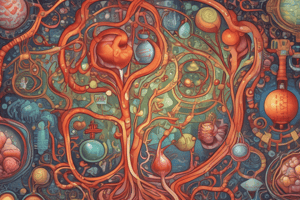Podcast
Questions and Answers
What is the primary distinction between catabolic and anabolic reactions?
What is the primary distinction between catabolic and anabolic reactions?
- Catabolic reactions are spontaneous while anabolic reactions are not.
- Catabolic reactions consume energy while anabolic reactions release energy.
- Catabolic reactions occur in plants while anabolic reactions occur in animals.
- Catabolic reactions release energy while anabolic reactions consume energy. (correct)
Which type of reaction is characterized as spontaneous and does not require energy input?
Which type of reaction is characterized as spontaneous and does not require energy input?
- Anabolic reaction
- Exergonic reaction (correct)
- Metabolic reaction
- Endergonic reaction
What is the primary role of ATP in cellular processes?
What is the primary role of ATP in cellular processes?
- To serve as a structural component of cells.
- To shuttle energy necessary for cellular work. (correct)
- To act as a storage form of genetic information.
- To decompose waste materials in the cell.
How do enzymes affect metabolic reactions?
How do enzymes affect metabolic reactions?
Which reaction is an example of an endergonic process?
Which reaction is an example of an endergonic process?
What enables ATP to drive endergonic reactions?
What enables ATP to drive endergonic reactions?
Which statement accurately describes ATP hydrolysis?
Which statement accurately describes ATP hydrolysis?
Which of the following statements about metabolism is true?
Which of the following statements about metabolism is true?
What happens to an enzyme's shape when it binds its substrate?
What happens to an enzyme's shape when it binds its substrate?
How do enzymes primarily speed up chemical reactions?
How do enzymes primarily speed up chemical reactions?
Which of the following factors does NOT typically affect enzyme activity?
Which of the following factors does NOT typically affect enzyme activity?
What are the two types of enzyme inhibitors?
What are the two types of enzyme inhibitors?
What occurs when an enzyme's temperature exceeds its optimal range?
What occurs when an enzyme's temperature exceeds its optimal range?
Which factor is necessary for the regulation of enzyme activity?
Which factor is necessary for the regulation of enzyme activity?
What is one way enzymes lower the activation energy barrier?
What is one way enzymes lower the activation energy barrier?
How do changes in pH affect enzyme activity?
How do changes in pH affect enzyme activity?
Study Notes
Metabolism
- Metabolism is the collection of chemical reactions that occur in living organisms.
- Metabolism is comprised of catabolism and anabolism.
- Catabolism breaks down molecules, releasing energy.
- Anabolism builds molecules, consuming energy.
- Enzymes catalyze reactions in both catabolic and anabolic metabolic pathways.
Exergonic and Endergonic Reactions
- Exergonic reactions are spontaneous, releasing energy.
- Examples of exergonic reactions include catabolic reactions and ATP hydrolysis.
- Endergonic reactions are non-spontaneous and require an input of energy.
- Examples of endergonic reactions include anabolic reactions and ATP synthesis.
ATP (Adenosine TriPhosphate) Cycle
- ATP is the cell's primary energy currency.
- ATP hydrolysis is an exergonic reaction that releases energy, breaking down ATP into ADP + P.
- ATP synthesis is an endergonic reaction requiring energy to combine ADP + P to create ATP.
- Catabolic pathways drive the regeneration of ATP through energy coupling.
ATP's Functions
- ATP powers cellular work by coupling exergonic reactions with endergonic reactions.
- Energy coupling involves transferring a phosphate group from ATP to specific reactants, forming a phosphorylated intermediate that is more reactive.
Enzymes
- Enzymes are macromolecules, primarily proteins, that act as catalysts.
- Enzymes speed up reactions without being consumed in the process.
- Each enzyme has a unique active site that binds specifically to its substrate, the reactant molecule it acts on.
- The enzyme's shape can change slightly when it binds to its substrate, called induced fit.
- Enzyme activity can be described by the following: E + S → ES → P + E (where E = enzyme, S = substrate, ES = enzyme-substrate complex, and P = product).
Enzymes and Activation Energy
- Enzymes speed up reactions by lowering the activation energy barrier.
- Activation energy is the energy required to break the bonds of reactants.
- Enzymes lower the activation energy barrier by:
- Orienting substrates correctly
- Straining their bonds
- Providing a favorable microenvironment
- Covalently bonding with the substrate
Regulation of Enzyme Activity
-
Enzyme activity can be regulated by activation, inhibition, or stabilization.
-
Enzyme activity is affected by environmental and chemical factors.
-
Environmental Factors:
- Temperature: Each enzyme has an optimal temperature. Above a critical temperature, enzyme activity drops rapidly as the enzyme denatures (unfolds).
- pH: Each enzyme has an optimal pH. Changes in pH affect enzyme activity due to the acidic and basic properties of amino acids.
-
Chemical Factors:
- Salt concentration: Can affect enzyme structure and function.
- Cofactors: Non-protein molecules that assist enzyme activity, such as metal ions or vitamins.
- Inhibitors: Molecules that reduce enzyme function. There are two types of inhibitors: Competitive and non-competitive.
- Enzyme concentration: Increased concentration of enzyme leads to increased reaction rate.
- Allosteric regulators: Regulatory molecules bind to specific sites on the enzyme, altering its shape and function. These regulators can either activate or inhibit function.
Studying That Suits You
Use AI to generate personalized quizzes and flashcards to suit your learning preferences.
Related Documents
Description
Test your understanding of metabolism, including the roles of catabolism and anabolism. Explore the differences between exergonic and endergonic reactions, as well as the ATP cycle. This quiz covers essential concepts related to energy transformations in living organisms.




